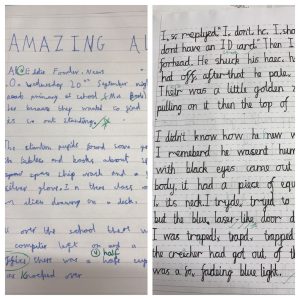- TEAM CURBAR
- OUR LEARNING
- Curbar Curriculum
- Teaching and Learning at Curbar 2023 – 2024
- Bumble Bees – Reception
- Busy Bees – Years 1 and 2
- Birch – Years 3 and 4
- Elder – Years 5 and 6
- Remote Learning
- Forest School and Outdoor Learning at Curbar
- Purple Mash
- How to stay safe online
- ALL ABOUT US
- PARENT ZONE
- INFORMATION
- Safeguarding is everyone’s business!
- Admissions Information 2023 – 24
- Anti Bullying Commitment
- End of Key Stage results 2018 – 19
- GDPR (General Data Protection Regulations)
- Pupil Premium and Recovery Premium 2023
- PE and Sport Premium 2023
- OFSTED
- SEND Information 2023 – 24
- School Policies and Procedures
- School Improvement 2023 – 24
- CONTACT

- TEAM CURBAR
- OUR LEARNING
- Curbar Curriculum
- Teaching and Learning at Curbar 2023 – 2024
- Bumble Bees – Reception
- Busy Bees – Years 1 and 2
- Birch – Years 3 and 4
- Elder – Years 5 and 6
- Remote Learning
- Forest School and Outdoor Learning at Curbar
- Purple Mash
- How to stay safe online
- ALL ABOUT US
- PARENT ZONE
- INFORMATION
- Safeguarding is everyone’s business!
- Admissions Information 2023 – 24
- Anti Bullying Commitment
- End of Key Stage results 2018 – 19
- GDPR (General Data Protection Regulations)
- Pupil Premium and Recovery Premium 2023
- PE and Sport Premium 2023
- OFSTED
- SEND Information 2023 – 24
- School Policies and Procedures
- School Improvement 2023 – 24
- CONTACT
- TEAM CURBAR
- OUR LEARNING
- Curbar Curriculum
- Teaching and Learning at Curbar 2023 – 2024
- Bumble Bees – Reception
- Busy Bees – Years 1 and 2
- Birch – Years 3 and 4
- Elder – Years 5 and 6
- Remote Learning
- Forest School and Outdoor Learning at Curbar
- Purple Mash
- How to stay safe online
- ALL ABOUT US
- PARENT ZONE
- INFORMATION
- Safeguarding is everyone’s business!
- Admissions Information 2023 – 24
- Anti Bullying Commitment
- End of Key Stage results 2018 – 19
- GDPR (General Data Protection Regulations)
- Pupil Premium and Recovery Premium 2023
- PE and Sport Premium 2023
- OFSTED
- SEND Information 2023 – 24
- School Policies and Procedures
- School Improvement 2023 – 24
- CONTACT
We want all of our children to take pride in their presentation and we advocate a semi cursive style of handwriting throughout school. We aim to make handwriting an automatic process that does not interfere with creative and mental thinking. We promote and teach handwriting in Key Stage 1. As children progress through key stage 2 they will continue to work on the size and orientation of their letter formation. Once a consistent, fluid and correctly orientated script is achieved children will achieve their pen licence ( a licence to ‘quill’) and will write in a special handwriting pen.
We teach a ‘semi-cursive’ style of writing at Curbar, an example of each letter can be seen here:
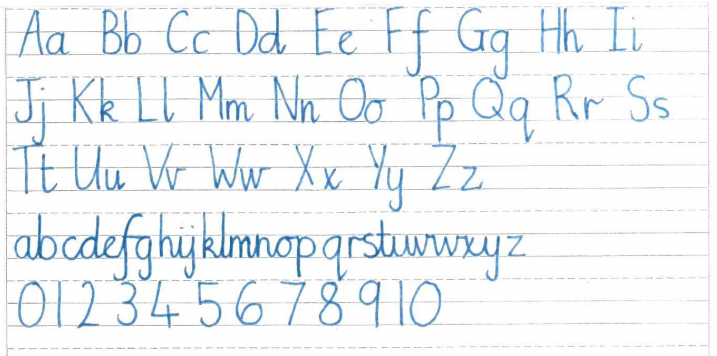
The main difference between this style and more complicated cursive styles is that the letters do not have a ‘lead in’ stroke. This means that letters are formed the same way whether they are joined or not. Children are initially taught each individual letter before learning how to join them in discreet handwriting sessions two or three times a week.
Handwriting Lines
Children are supported with different sized spaces between the handwriting guide lines depending on the size of their handwriting and fine motor ability. The children learn the vocabulary of top broken line, top solid line, bottom solid line and bottom broken line to refer to each of the guide lines. The consistency in this means that all children and adults can explain where letters begin and how they are formed.
Children are supported with different sized spaces between the handwriting guide lines depending on the size of their handwriting and fine motor ability. The children learn the vocabulary of top broken line, top solid line, bottom solid line and bottom broken line to refer to each of the guide lines. The consistency in this means that all children and adults can explain where letters begin and how they are formed.

We use four sizes of handwriting lined paper with size 1 being the largest and size 4 being the smallest.
Types of letters
Letters that reach the top broken line are referred to as ‘tall’ letters. Letters that sit between the two solid lines are ‘short’ letters and those which reach the bottom broken line are ‘tail’ letters. Here are some examples:
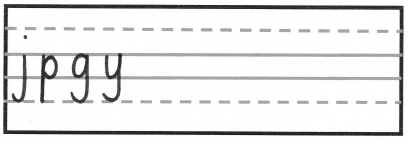
Tail letters.
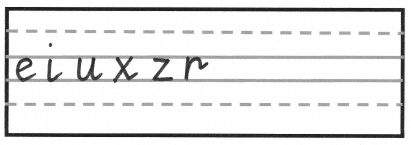
Small letters.
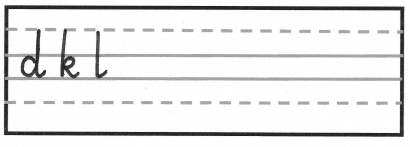
Tall letters.
Letter families
Lowercase letters are grouped into the following letter families.
The straight line family Letters based on a single vertical line
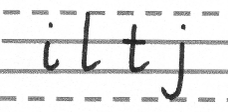
The coat-hanger family Letters based on a ‘c’ shape
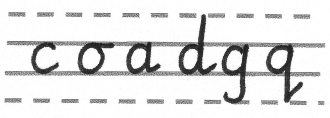
Letter e (the distant cousin of the coat-hanger family, begins differently but still based on a ‘c’ shape.

The bridge family letters that have a vertical down stroke followed by a diagonal movement to the right.
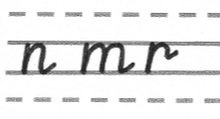
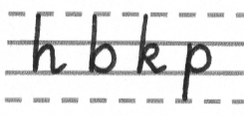
The zig-zag family Both letters start on the top solid line, have a diagonal stroke and have joining mark that sits on the top solid line.
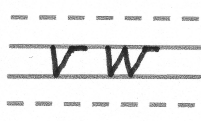
The smile family Both letters start on the top solid line, begin with a downward stroke, curve back up to the top solid line and then down to the bottom solid line.
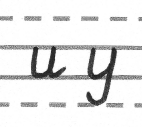
The misfits! Letters that are unique and individual and do not fit with any other letter groups.
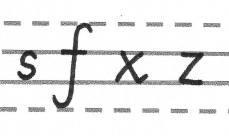
Joining letters
When children are ready, they are taught when, how and when not to (we call these break letters) join letters together. Have a look at our example again to see where these break letters are:

© Copyright 2023 Curbar Primary School
Telephone- 01433 630266 | Email- enquiries@curbar.derbyshire.sch.uk
